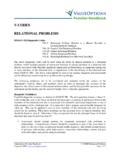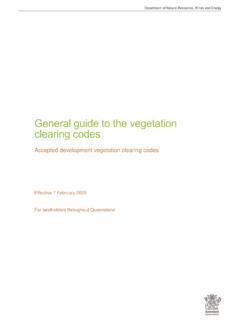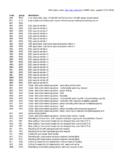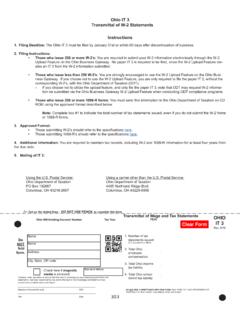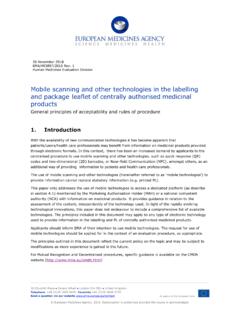Transcription of DSM-5 codes - University of Toronto
1 DSM-5 codes40 DSM-5 codesThis article gives an overview of diagnostic codes from DSM-5 , the fifth edition of the American PsychiatricAssociation's Diagnostic and Statistical Manual of Mental disordersDisorders with onset in the developmental period, often before starting school, and characterized by a range ofdevelopmental deficits that impair normal functioning.[] Intellectual developmental disorderDeficits in intellectual functioning and every day adaptive functioning with onset during the Global developmental delayPertains to those under 5 years old whose intellectual functioning can not be systematically assessed.
2 319 Unspecified intellectual disability (Intellectual developmental disorder)Used in exceptional circumstances for individuals over 5 years old whose intellectual disability cannot beassessed because of sensory or physical impairments. Communication disordersDeficits in language, speech, or in any behaviors affecting verbal and nonverbal communications Language disorderPersistent deficits in comprehension or production of language ( spoken, written, sign language)substantially below age level, beginning in the early developmental period, and not due to other disorders orconditions Speech sound disorderPersistent deficits in speech sound production, below that expected of age and developmental level, not due toother impairments such a physical, neurological or hearing disorders or conditions Childhood-onset fluency disorder (stuttering)Disturbance in normal speech patterns and fluency that interferes with normal achievement Social (Pragmatic)
3 Communication disorderPrimary deficits in understanding and following social practices of verbal and nonverbal communication innormal settings that functionally impair the individual; not better explained by other deficits Unspecified communication disorderClinically significant symptoms of a communication disorder, but fails to meet the full criteria for any of thecommunication or neurodeveopmental disorders and the clinician does not specify the reason Autism spectrum disorderPersistent communication and social interaction deficits in multiple situations.
4 Restricted, repetitive behaviorand interests, originally manifested in the early developmental period and causing significant impairmentDSM-5 codes41 Specify if:With or without accompanying intellectual impairmentWith or without accompanying language impairmentAssociated with a known medical or genetic condition or environmental factorAssociated with another neurodevelopmental, mental, or behavioral disorderWith catatonia Attention-deficit/Hyperactivity disorder (ADHD)"Persistent pattern of inattention and/or hyperactivity-impulsivity that interferes with functioning ordevelopment" beginning in childhood, and present across more than one setting[]Specify whether.
5 Combined presentation Predominantly inattentive presentation Predominantly hyperactive/impulsive presentationSpecify if:In partial remissionSpecify current severity:MildModerateSevere Other specified attention-deficit/Hyperactivity disorderSymptoms of ADHD are present and cause significant impairment in important functional areas, but do notmeet the full criteria, and where the reason for failing the criteria is specified. Unspecified attention-deficit/Hyperactivity disorderSame as above but with no reason specified or insufficient information is available to provide one Specific learning disorderA neurodevelopmental disorder of biological origin manifested in learning difficulty and problems inacquiring academic skills markedly below age level and manifested in the early school years, lasting for atleast 6 months.
6 Not attributed to intellectual disabilities, developmental disorders, or neurological or motordisordersSpecify if: With impairment in reading With impairment in written expression With impairment in mathematicsSpecify current severity:MildModerateSevere Motor disorders.[] Developmental coordination disorderMotor skill development substantially below age group, interfere with normal activities, and begin in "early developmental period". Not better accounted for by intellectual disabilities, visual problems, or a neurologicalDSM-5 codes42condition such as cerebral palsy, or a degenerative disorder.
7 Stereotypic movement disorderRepetitive, seemingly purposeless, often rhythmical motor behavior that interferes with normal activities, withonset in the "early developmental period".Specify if:With self-injurious behaviorWith-out self-injurious behaviorSpecify if:Associated with a known medical or genetic condition, neurodevelopmental disorder, or environmentalfactorSpecify current severity:MildModerateSevere Tic disorders"A tic is a sudden, rapid, recurrent, nonrhythmic motor movement or vocalization". Tic disorders are not dueto use of a substance or to another medical condition; the diagnosis depends on the lack of any known cause.
8 [] Tourette's disorderMultiple motor tics and at least one vocal tic present for more than one year, though not necessarily at thesame time, with onset before age 18. Persistent (Chronic) motor or vocal tic disorderAt least one motor or vocal tic, but not both; must be present for more than one year with onset before age if:With motor tics onlyWith vocal tics only Provisional tic disorderOne or more motor and/or vocal tics, present for less than one year; onset before age 18. Other specified tic disorderCharacteristic tic disorder symptoms causing distress or impairment but not meeting the "criteria for a ticdisorder or any specific neurodevelopmental disorder".
9 The specific reason given onset over the age of 18 Unspecified tic disorder[]Same as " Other specified tic disorder", but the reason is not specified Other neurodevelopmental disorders Other specified neurodeveopmental disorderA category that pertains to characteristic symptoms of a neurodevelopmental disorder causing significantimpairment but does not fulfill the criteria of a specific diagnostic : Specific reason, such as "associated with prenatal alcohol exposure" Unspecified neurodevelopmental disorderA category similar to , but without a specified codes43 Schizophrenia spectrum and other psychotic disordersKey features that define the psychotic disorders in DSM-5 are:[]Delusions - fixed beliefs not open to change even when evidence contradicts them.
10 Termed bizarre ifimplausible and not derived from ordinary experienceHallucinations - involuntary sensory experiences not related to external stimuliDisorganized thinking (speech) - derailment of focal topic or loose associations, incoherenceGrossly disorganized or abnormal motor behavior (including catatonia)Negative symptoms - reduced emotional expression, avolition, alogia, anhedonia, asociality Delusional disorder - presence of one or more fixed delusions, but otherwise functioning usually is notnoticeably impaired.[]Specify whether:Erotomanic typeGrandiose typeJealous typePersecutory typeSomatic typeMixed typeUnspecified typeSpecify if:With bizarre contentSpecify if:First episode, currently in acute episodeFirst episode, currently in partial remissionFirst episode, currently in full remissionMultiple episodes, currently in acute episodeMultiple episodes, currently in partial remissionMultiple episodes, currently in full remissionUnspecifiedSpecify current severity.
